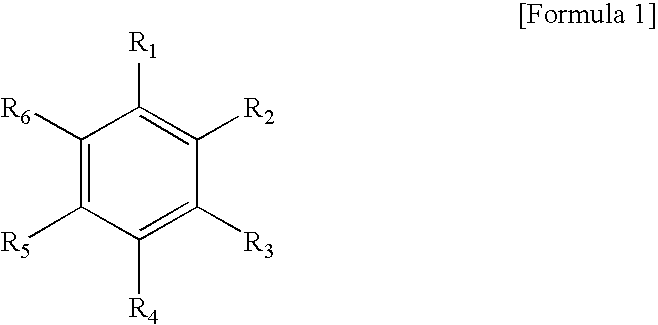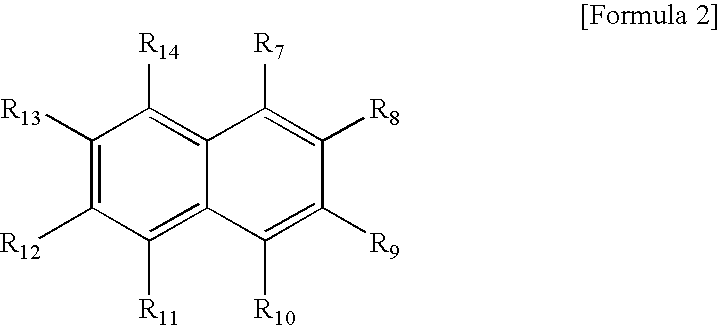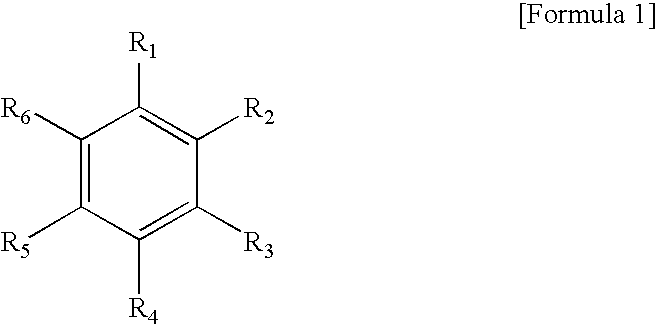Environmentally benign and simplified method for preparation of aromatic dicarboxylic acid
a technology of aromatic dicarboxylic acid and simplified method, which is applied in the preparation of carboxylic compounds, organic chemistry, chemistry apparatus and processes, etc., can solve the problems of various problems of conventional oxidation reaction system, various problems to be solved, and use of bromine as reaction initiator, etc., to reduce the reactivity, improve the reactivity, and improve the reactivity
- Summary
- Abstract
- Description
- Claims
- Application Information
AI Technical Summary
Benefits of technology
Problems solved by technology
Method used
Image
Examples
example 1
[0075]15 g of para-Xylene (PX), 40 g of para-toluic acid (p-tol), and 20 g of water were added to a reactor, and were mixed to prepare a feed mixture. Mn(CH3COO)2.4H2O or Co(CH3COO)2.4H2O was used as a reaction catalyst in an amount according to Table 1. Then, at 190° C. under pressure of 2.5 MPa, air was continuously introduced at a flow rate of 0.5 L / min to perform an oxidation reaction.
[0076]The yields of terephthalic acid were obtained as noted in Table 1.
TABLE 1ManganeseCobalt acetateReactionYield of terephthalicacetate (g)(g)time (min)acid (mol %)10.100.10 90229.10.200.10185113.40.200.07250134.00.270.07250129.80.350.07180130.11Calculated on PX2The reaction was automatically stopped
example 2
[0077]An oxidation reaction was performed in the same manner as described in Example 1, except that 40 g of water, instead of 20 g of water, was used, and catalysts were introduced in an amount according to Table 2.
[0078]The yields of terephthalic acid were obtained as noted in Table 2.
TABLE 2ManganeseCobaltReaction timeYield of terephthalicacetate (g)acetate (g)(min)acid (mol %)10.40—180 124.40.30—90230.40.300.1590224.70.250.1590231.40.200.1590228.10.150.1580226.91Calculated on PX2The reaction was automatically stopped
[0079]In Example 1 and Example 2, 20 g of water and 40 g of water were used, respectively. In both Examples, the increase in the amount of manganese and the decrease in the amount of cobalt resulted in increase of a reaction yield. Especially, when a large amount of water is introduced, the yield of the reaction can be significantly increased only if cobalt is not introduced.
[0080]The following Example 3 shows the changes in the yield of terephthalic acid (aromatic d...
example 3
[0081]8 g of para-Xylene (PX), 15.3 g of para-toluic acid (p-tol), and 6.5 g of water were added to a reactor, and were mixed to prepare a feed mixture. 0.23 g of Mn(CH3COO)2.4H2O together with a sub catalyst as noted in Table 3 were used as reaction catalysts. Then, at 195° C. under pressure of 2.5 MPa, air was continuously introduced at a flow rate of 0.180 L / min to perform an oxidation reaction.
[0082]As noted in Table 3, when titanium was introduced as a sub catalyst, the reaction yield was the highest, and on the other hand, when iron was introduced, the reaction yield was decreased.
TABLE 3Amount ofYield of terephthalicSub catalystintroduction (g)acid (wt %)1Not introduced0.0280.7Ni-acetate0.0282.7Zr-acetate0.0284.2Ti-sulfate0.0290.3Fe-acetate0.0274.2Cr-acetate0.0281.11Calculated on PX and p-tol
[0083]The following Example 4 shows the effect of the amount of CO2 introduced on the changes in the yield of terephthalic acid (aromatic dicarboxylic acid) and the selectivity, when wate...
PUM
| Property | Measurement | Unit |
|---|---|---|
| temperature | aaaaa | aaaaa |
| weight | aaaaa | aaaaa |
| partial pressure | aaaaa | aaaaa |
Abstract
Description
Claims
Application Information
 Login to View More
Login to View More - R&D
- Intellectual Property
- Life Sciences
- Materials
- Tech Scout
- Unparalleled Data Quality
- Higher Quality Content
- 60% Fewer Hallucinations
Browse by: Latest US Patents, China's latest patents, Technical Efficacy Thesaurus, Application Domain, Technology Topic, Popular Technical Reports.
© 2025 PatSnap. All rights reserved.Legal|Privacy policy|Modern Slavery Act Transparency Statement|Sitemap|About US| Contact US: help@patsnap.com



